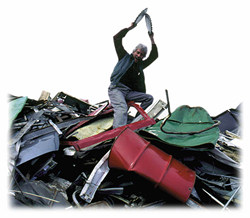by Reena Kazmann / Eco-Artware.com
Recently we met up with two professional artists who have written books about sustainable art, and practice what they preach.
Bernice P. Arthur is an artist whose paintings, prints and mini-sculpture are exhibited in galleries in the Boston, Massachusetts area. She's written and self-published The Art of Recycling, a book of ideas, to help teachers develop stimulating projects. Her insights on what to do with old maps may be found in the "Crafts by You" archives at Eco-Artware.com.
 Daisy Montage by Bernice P. Arthur,
using typewriter ribbon cover, Scotch tape dispenser, metal brooch,
typewriter ribbon, vintage typewriter ribbon holders and mat discards.
Daisy Montage by Bernice P. Arthur,
using typewriter ribbon cover, Scotch tape dispenser, metal brooch,
typewriter ribbon, vintage typewriter ribbon holders and mat discards.
Arthur says, "I do not take life lightly." Her recycled art uses "bones, beads, stones and shell - pretty silly stuff - to make 'serious' art."
When Bobby Hansson suggested a book on tin can art, many people - including his publisher - thought he was crazy. But The Fine Art of the Tin Can, which showcases 101 projects made from tin cans is so successful, it is spawning a sequel.
For 35 years Hansson did photography for art museum catalogs and crafts books before deciding to do his own book. Hansson's book was inspired by his genuine love of tin cans. As a kid he recalls making tin can headlights for his box cars, as well as walking stilts.
He also wanted to promote the concept that materials such as tin cans should be thought of as resources, rather than waste.
 Donald Knaack scours trash
heaps for tin cans, automobile parts, bottles, pots, scrap metal and wood
to make music from.
Donald Knaack scours trash
heaps for tin cans, automobile parts, bottles, pots, scrap metal and wood
to make music from.
Like others in the sustainable art movement, Donald Knaack scours trash heaps for tin cans, automobile parts, bottles, pots, scrap metal and wood. But what he creates from these discards is truly unique. Knaack, who uses moniker, The Junkman, creates music from these cast-offs.
Knaack's music is not your garden-variety rhythm band. His compositions contain an infinite variety of textures and rhythms. From metal, wood, paper and plastic, he makes classical, Latin, jazz, rock, and contemporary music. Indeed, his 1998 CD "Junk Music" was a finalist for the Best Classical Composition Grammy.
And his recent musical composition, commissioned by modern dancer Twyla Tharp, accompanies Tharp's newly choreographed, Surfer at the River Styx, performed at Washington, DC's Kennedy Center, and soon to be performed at New York's Joyce Theatre.
Knaack came by his uncommon music by common roots--a graduate degree in music from New York's acclaimed Manhattan School of Music. Twenty-two years ago, as a percussionist for the Louisville (Kentucky) Orchestra, Knaack found himself in a junkyard looking for metal slabs to use to create sounds for a contemporary work that the orchestra was performing. As he tapped away on pieces of metal, Knaack was overwhelmed by the variety of sounds he could create. He soon discovered that he could make music on practically anything.
Eight years ago Knaack began composing for and performing on recycled materials exclusively when he realized that he "no longer heard traditional instruments," in his head as he composed. Instead, he heard "junk instruments."
Today, his Vermont warehouse is full of objects that produce thousands of sounds. He compares the process of composing for junk to that of an artist with a multi-colored palette. Like an artist who knows what mixing red and yellow will produce, Knaack knows the sounds that each of his junk instruments make and what the music will sound like when the instruments are blended together.
While Knaack is capable of producing extraordinary music with his junk collection, what he likes about Junk Music is that you don't have to have exceptional musical talent to play it. It is accessible to everyone. In war-torn Croatia, Knaack took the remnants of war-trashed buildings and artillery shells. He used them to create music, transforming "negative energy into something positive." He taught Croatian students how to create music from the artifacts of destruction.
In the US, Knaack brings Junk Music into schools, with his Residency Programs. In a day-long residency, Knaack gets kids playing music on junk instruments. Knaack says that they very quickly "get a sense of the joy of music" that often takes years of practice on traditional instruments. With junk, says Knaack, you "feel the power of rhythm. It gets you hooked on music and once you get it you never forget it."
In longer residencies, Knaack works with schools or the community to build Junk Music Playstations, a "sound" sculpture constructed from materials found in recycle bins, storage sheds and landfills. These percussion-based musical sculptures are played by shaking, rubbing or striking the junk instruments. Once constructed, from 6 to 20 people play together in a "Junkjam."
Knaack is currently planning a mega-junkjam for December 10, 2000 at the Percussive Arts Society, in Lawton, Oklahoma. Here, more than 100 students, playing on a half-dozen Playstations, will lead the community in a concert, setting the world record for the largest Junkjam. No doubt it will also go down in record books as music's most creative recycling project.
To learn more about Junk Music or a Residency Program, contact: Donald Knaack (phone) 802-236-0088, e-mail junkman@vermontel.com, or visit his Wwebsite at http://www.vermontel.com/~junkman/
RETURN TO OMPLACE HOME